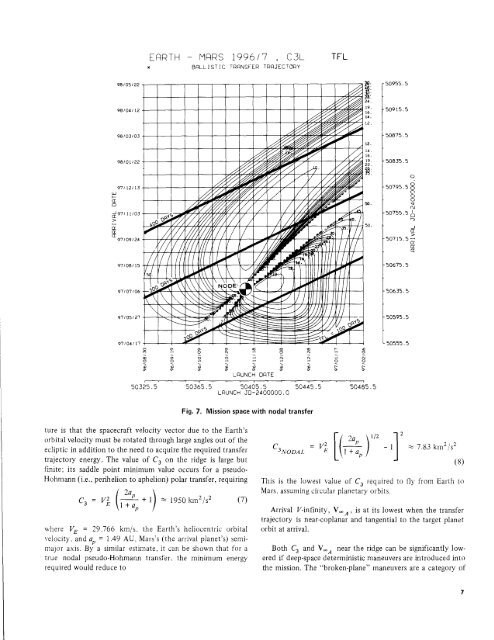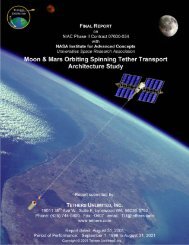Interplanetary Mission Design Handbook, Volume I, Part 2
Interplanetary Mission Design Handbook, Volume I, Part 2
Interplanetary Mission Design Handbook, Volume I, Part 2
Create successful ePaper yourself
Turn your PDF publications into a flip-book with our unique Google optimized e-Paper software.
ture is that the spacecraft velocity vector due to the Earth's<br />
orbital velocity must be rotated through large angles out of the<br />
ecliptic in addition to the need to acquire the required transfer<br />
trajectory energy . The value of C 3 on the ridge is large but<br />
finite ; its saddle point minimum value occurs for a pseudo-<br />
Hohmann (i .e ., perihelion to aphelion) polar transfer, requiring<br />
C3<br />
V2<br />
lP<br />
1 2a<br />
1 + a + 1l 1950 km 2 /s 2 (7)<br />
where VE = 29 .766 km/s, the Earth's heliocentric orbital<br />
velocity, and aP = 1 .49 AU, Mars's (the arrival planet's) semimajor<br />
axis . By a similar estimate, it can be shown that for a<br />
true nodal pseudo-Hohmann transfer, the minimum energy<br />
required would reduce to<br />
C3woDAL -<br />
VE<br />
1 +<br />
2aP<br />
1/2 2<br />
a , - 1 7 .83 km 2 /s 2<br />
P<br />
This is the lowest value of C3 required to fly from Earth to<br />
Mars, assuming circular planetary orbits .<br />
Arrival V-infinity, V_ A , is at its lowest when the transfer<br />
trajectory is near-coplanar and tangential to the target planet<br />
orbit at arrival .<br />
Both C3 and V_ A near the ridge can be significantly lowered<br />
if deep-space deterministic maneuvers are introduced into<br />
the mission . The "broken-plane" maneuvers are a category of<br />
(8)









